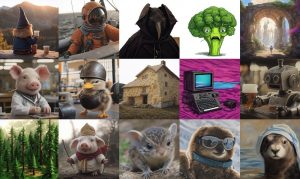Why The World Needs the an Augmented Reality Conference (and Why We’re Hosting It)
[Editor’s Note: Lee Dryburgh runs the Emerging Communications conference, a great source of interesting opinions and cutting edge information on the whole Infrastructure 2.0 world. He is announcing the co-location of the world’s first conference on AR, which is newsworthy enough to share with you, but the journey as to why the world needs this conference warranted posting in full here at SiliconANGLE. This was cross-posted on the eComm mailing list and the conference blog. –mrh]
Mobile AR is ushering in a decade of development and opportunity analogous to the introduction of GSM or the first consumer web browser at the start of the 1990s. If you attend the Emerging Communications Conference & Awards April 19-21, you can get into the co-located, Augmented Reality Conference, free of charge. This will be the world’s first commercial augmented reality event.
Let Me Explain
![]() In the 1990s two major transformative technologies took hold. The cellular telephone and the web browser. I believe that we’re yet again on the cusp of such a decade long transformation.
In the 1990s two major transformative technologies took hold. The cellular telephone and the web browser. I believe that we’re yet again on the cusp of such a decade long transformation.
Using the web broswer for analogy I believe we’ve stepped firmly onto Gopher territory now. Mosaic is less than two years away. Using the mobile analogy instead, the first GSM call has just been made. The first text message is around a year away.
Unfortunately though, the label for the technology conjures up associations steeped in academia. That label is "augmented reality" (AR) which I’ll take a loose definition on of "technology for overlaying and infusing the physical world with digital media, information and experiences"; or as Network World put it "a new interactive relationship between mobile users and their surroundings". Gone are the ridiculously large backpacks and head-up displays. Instead successful first-generation services are now pouring out on cutting-edge smart phones (iPhone 3GS and certain Android based models, currently). It’s also coming tantalizingly close to being available on "Matrix-style" glasses at consumer price point.
AR combines mobile computing, ubiquitous computing, semantic and metadata, contextualized media, and locative/geospatial content. This represents a paradigm shift reaching the scale of the Internet itself.
Gartner Research expects AR to be used by more than 30% of the mobile workforce by 2014. According to Gartner’s definition it will cause a major change in the "accepted way of doing things," including business models, industry dynamics, processes, revenue streams, and consumer behavior. Nearly every industry will be impacted; advertising, architecture, tourism, conferencing, entertainment, education, military, emergency services, healthcare, productivity, manufacturing, business, publishing, navigation, governance, financial services and so on. It will fundamentally change the way people interact with computers, the world around us, and each other.
I’m not sure what will pull ahead first in terms of user cases, but as an example I think it’s clear that AR for home shopping will be a success as it allows consumers to "see" what could be in the comfort of their own home (and with the ability to purchase the products they’ve previewed right within the mobile AR app). Probably "green-tech" AR apps are a solid first bet too. But then again, could you imagine someone speculating how the web browser could be used commercially, circa 1991?
There are still friction points, for example Apple have not yet opened up their camera API to developers for the analysis of live-streaming. However it’s expected though that Apple will change their position in the short-medium term.
It was clear that AR was flying out of the hands of academia, into business and into our lives during the European version of the Emerging Communications Conference & Awards (eComm) last October.
Convergence and Disruption
Mark Rolston of frog Design, who won the Most Visionary Speaker Award with his talk Evolving from Mobile Devices to the Ubiquitous Digital Life made three statements during the course of his presentation which resonated deeply with me:
"our spaces are becoming the computer" – Mark Rolston
"our things are becoming the computer" – Mark Rolston
"we are becoming the computer" – Mark Rolston
The video of which will be made available online in the coming weeks.
In the presentation before Mark Rolston, Claire Boonstra gave a demo of Layer , an augmented reality browser. Layar was proving that business can be done now, i.e. developers are making money out of Layar. Layar won the Communications Application Award. Incidentally Google Wave won the Communications Technology Award and the area that I’m most excited about is combining the communication protocols Wave, regular XMPP (it forms part of the Wave standards) and Augmented Reality. I’m hoping that leading communication innovators such as Voxeo, if they aren’t’ already, pour some man-hours into that space.
I’ll stop there for now by giving a quote from Vernor Vine at the start of ISMAR 2009:
"Imagine an environment where most physical objects know where they are, what they are, and can, (in principle) network with any other object. With this infrastructure, reality becomes its own database. Multiple consensual virtual environments are possible, each oriented to the needs of its constituency… the physical world becomes much more like a software construct. The possibilities are both scary and wondrous."
To make this happen at the expected world-class level and provide free seats toeComm attendees – if you’re in the field of AR I need your support – email me with any suggestions or offers, thanks! (use lee.dryburgh@eComm.ec). There are speaking slots left for both the Augmented Reality Conference (around 50% are left) and for the Emerging Communications Conference & Awards, America 2010 (around 35% are left).
If you’re connected in the AR community please do reach out to your friends and colleagues and make them aware. By bringing together the strong and influential communications innovation community of ecomm together in the same vicinity as the AR community, extra special things will happen this year.
If you’re interested in purchasing ticket for eComm, the "friends" rate runs out today; it’s intended for people who already know the event and who are prepared to purchase tickets in advance of speakers being announced. But not to worry otherwise as it’s a super early bird rate after that.
A message from John Furrier, co-founder of SiliconANGLE:
Your vote of support is important to us and it helps us keep the content FREE.
One click below supports our mission to provide free, deep, and relevant content.
Join our community on YouTube
Join the community that includes more than 15,000 #CubeAlumni experts, including Amazon.com CEO Andy Jassy, Dell Technologies founder and CEO Michael Dell, Intel CEO Pat Gelsinger, and many more luminaries and experts.
THANK YOU













